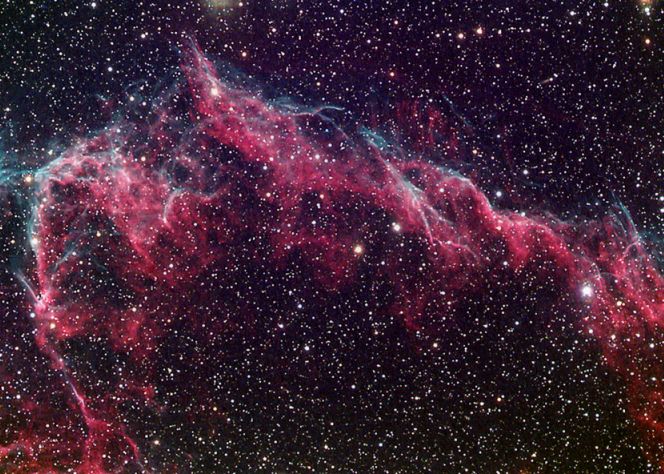Credit & Copyright: Steve Mandel,
Hidden Valley Observatory
Explanation:
After 5,000 years, the gorgeous
Veil
Nebula is still turning heads.
Cataloged as NGC 6992, these glowing
filaments of interstellar
shocked gas are part of a larger spherical
supernova remnant known as the
Cygnus Loop or the
Veil Nebula -- expanding debris from a star which
exploded over 5,000 years ago.
This color digital image of a
bit
of the Veil has been processed
and enhanced to reveal stunning details in the diaphanous cosmic cloud.
Seen from our perspective against a rich Milky Way star field,
the Veil Nebula is
now
known to lie some 1,400 light-years away toward the
constellation Cygnus.
At that distance,
witnesses
to the original stellar explosion would have
seen a star in the heavens
increase in brightness to about -8 magnitude, roughly corresponding to
the brightness of the crescent Moon.
1999 2000 2001 2002 2003 2004 2005 2006 2007 2008 2009 2010 2011 2012 2013 2014 2015 2016 2017 2018 2019 2020 2021 2022 2023 2024 2025 |
Январь Февраль Март Апрель Май Июнь Июль Август Сентябрь Октябрь Ноябрь Декабрь |
NASA Web Site Statements, Warnings, and Disclaimers
NASA Official: Jay Norris. Specific rights apply.
A service of: LHEA at NASA / GSFC
& Michigan Tech. U.
|
Публикации с ключевыми словами:
остаток Сверхновой - туманность петля Лебедя - туманность Вуаль - Veil Nebula - NGC 6992 - supernova remnant
Публикации со словами: остаток Сверхновой - туманность петля Лебедя - туманность Вуаль - Veil Nebula - NGC 6992 - supernova remnant | |
См. также:
Все публикации на ту же тему >> | |
